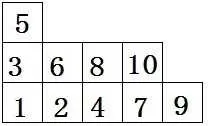poj2279——Mr. Young's Picture Permutations
Description
X X X X X
X X X
X X X
X
In addition, Mr. Young wants the students in each row arranged so that heights decrease from left to right. Also, student heights should decrease from the back to the front. Thinking about it, Mr. Young sees that for the 12-student example, there are at least two ways to arrange the students (with 1 as the tallest etc.):
1 2 3 4 5 1 5 8 11 12
6 7 8 2 6 9
9 10 11 3 7 10
12 4
Mr. Young wonders how many different arrangements of the students there might be for a given arrangement of rows. He tries counting by hand starting with rows of 3, 2 and 1 and counts 16 arrangements:
123 123 124 124 125 125 126 126 134 134 135 135 136 136 145 146
45 46 35 36 34 36 34 35 25 26 24 26 24 25 26 25
6 5 6 5 6 4 5 4 6 5 6 4 5 4 3 3
Mr. Young sees that counting by hand is not going to be very effective for any reasonable number of students so he asks you to help out by writing a computer program to determine the number of different arrangements of students for a given set of rows.
Input
Output
Sample Input
1
30
5
1 1 1 1 1
3
3 2 1
4
5 3 3 1
5
6 5 4 3 2
2
15 15
0
Sample Output
1
1
16
4158
141892608
9694845
Solution:
本题是lyd神犇的进阶指南上的DP题,状态转移方程看懂了,但是看似简单去实现有点复杂啊,于是取搜罗本题的勾长公式的解法。
杨表由有限的方格组成。
对于一个正整数,给定一个整数分拆λ(10=1+4+5),则对应一个杨表(注意这是一个递降的过程,也就是说下面一行的方格数要大于等于上一行的方格数)。
一个(1,4,5)分拆表示的杨表
杨表与整数分拆λ一一对应。
给定一个杨表,一共有n个方格。那么把1到n这n个数字填到这个杨表中,使得每行从左到右都是递增的,每列从下到上也是递增的。如图

一个杨表的表示
【勾长】对于杨表中的一个方格v,其勾长hook(v)等于同行右边的方格数加上同列上面的方格数,再加上1(也就是他自己)。
【勾长公式】用表示杨表个数,则
对于分拆10 = 5 + 4 + 1 的应的杨表. 因此共有
种方法。
公式题。求出同行右边的方格数+同列上面的方格数+1。唯一注意的地方是最后除的时候要防止溢出。
转载:
这个题嘛,标准做法是线性DP。
f[a1,a2,a3,a4,a5]表示每排从左起占了a1,a2,a3,a4,a5个人的方案数,f[0,0,0,0,0]=1。
转移方程为:当a1<N1,f[a1+1,a2,a3,a4,a5]+=f[a1,a2,a3,a4,a5],其余同理。
上面是lyd讲的,本蒟蒻觉得有点错,但说不清哪儿有问题(也可能本身没问题),路过的dalao帮看一看,谢告知。
那么简单做法就是:先去了解一下杨氏矩形和勾长公式,然后直接用公式做。我这种蒟蒻就选了这种方法……
杨氏矩阵定义(需满足的条件/特征):
(1)若格子(i,j),则该格子的右边和上边一定没有元素;
(2)若格子(i,j)有元素data[i][j],则该格子右边和上边相邻的格子要么没有元素,要么有比data[i][j]大的元素。
显然有同已写元素组成的杨氏矩阵不唯一,1~n组成杨氏矩阵的个数可以写出:
F[1]=1,F[2]=2,F[n]=F[n-1]+(n-1)*F[n-2] (n>2)。
钩子长度的定义:该格子右边的格子数和它上边的格子数之和;
钩子公式:对于给定形状,不同的杨氏矩阵的个数为(n!/(每个格子的钩子长度加1的积))。
知道了这些再做这个题就很方便了……
代码:
#include<bits/stdc++.h> #define ll long long #define il inline using namespace std; ll n,cnt,x,y,tmp,num[40],sum[5200]; il ll gcd(int a,int b){return b?gcd(b,a%b):a;} int main() { while(scanf("%lld",&n)&&n){ memset(sum,0,sizeof(sum)); cnt=0,x=1,y=1; for(int i=1;i<=n;i++)scanf("%lld",&num[i]); for(int i=1;i<=n;i++) for(int j=1;j<=num[i];j++){ cnt++; for(int k=i+1;k<=n;k++){ if(num[k]>=j)sum[cnt]++; else break; } sum[cnt]+=num[i]-j+1; } for(int i=1;i<=cnt;i++){ x*=i;y*=sum[i]; tmp=gcd(x,y); x/=tmp;y/=tmp; } printf("%lld ",x/y); } return 0; }
